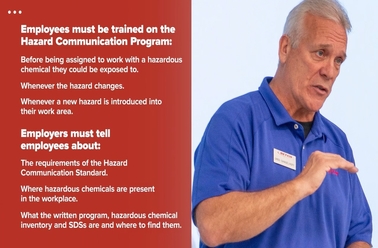This course helps employees learn how to safely work with or around hazardous chemicals. Available in English or Spanish .
Course Overview
The purpose of the Globally Harmonized System (GHS) is to standardize how we communicate about chemical hazards in the workplace. In 2012 OSHA put in place it's updated Hazard Communication Standard to align with the Globally Harmonized System commonly referred to as the GHS.
We will review information based on the Occupational Safety and Health Administration regulations as they relate to the hazard awareness and communication, hazard classification, Safety Data Sheets and labeling requirements of hazardous materials within the workplace. The updated Hazard Communication Standard is the core of this training and can be found in 29 CFR 1910.1200.
According to the Occupational Safety & Health Administration (OSHA), the GHS covers over 43 million workers who produce or handle hazardous chemicals in more than 5 million workplaces across the country. In addition, the GHS is estimated to prevent over 500 workplace injuries and illnesses and 43 fatalities annually, and result in cost savings to American businesses of more than $475 million in productivity improvements, fewer safety data sheet and label updates, and simpler new hazard communication training.
What you will learn
- Recognize the purpose and importance of a hazard communication program.
- Recognize common physical and health hazards associated with hazardous chemicals.
- Identify chemicals and their hazards, through labeling, markings, pictograms, and warning practices.
- Identify the purpose and components of a Safety Data Sheet










